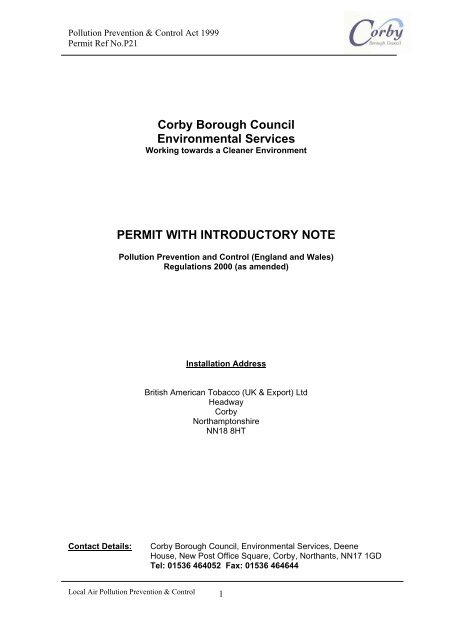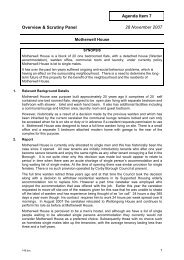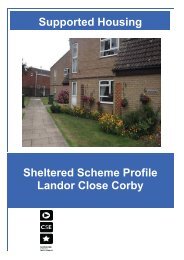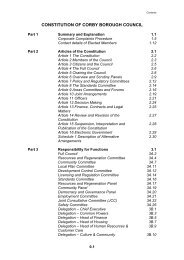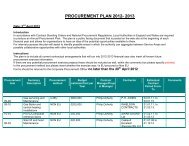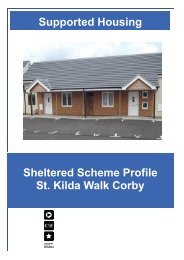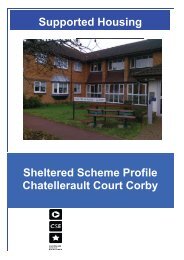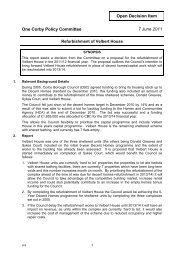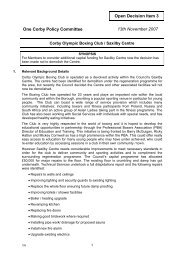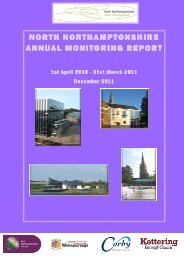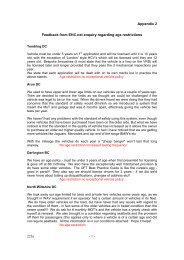British American Tobacco P21.pdf - Corby Borough Council
British American Tobacco P21.pdf - Corby Borough Council
British American Tobacco P21.pdf - Corby Borough Council
You also want an ePaper? Increase the reach of your titles
YUMPU automatically turns print PDFs into web optimized ePapers that Google loves.
Pollution Prevention & Control Act 1999<br />
Permit Ref No.P21<br />
<strong>Corby</strong> <strong>Borough</strong> <strong>Council</strong><br />
Environmental Services<br />
Working towards a Cleaner Environment<br />
PERMIT WITH INTRODUCTORY NOTE<br />
Pollution Prevention and Control (England and Wales)<br />
Regulations 2000 (as amended)<br />
Permit Referen<br />
Installation Address<br />
<strong>British</strong> <strong>American</strong> <strong>Tobacco</strong> (UK & Export) Ltd<br />
Headway<br />
<strong>Corby</strong><br />
Northamptonshire<br />
NN18 8HT<br />
Contact Details:<br />
<strong>Corby</strong> <strong>Borough</strong> <strong>Council</strong>, Environmental Services, Deene<br />
House, New Post Office Square, <strong>Corby</strong>, Northants, NN17 1GD<br />
Tel: 01536 464052 Fax: 01536 464644<br />
Local Air Pollution Prevention & Control 1
Pollution Prevention & Control Act 1999<br />
Permit Ref No.P21<br />
Pollution Prevention and Control Act 1999<br />
Pollution Prevention and Control (England and Wales)<br />
Regulations 2000 (as amended) Schedule 1<br />
Permit Reference No.P21<br />
Contents<br />
Section<br />
1. Introductory Note and Description of Permitted Installation<br />
2. Permit Conditions<br />
3. Location of Permitted Installation and Site Plan<br />
4. Explanatory Memorandum including Appeals Procedure.<br />
Local Air Pollution Prevention & Control 2
Pollution Prevention & Control Act 1999<br />
Permit Ref No.P21<br />
Section One<br />
Introductory Note<br />
&<br />
Description of Permitted<br />
Installation<br />
Local Air Pollution Prevention & Control 3
Pollution Prevention & Control Act 1999<br />
Permit Ref No.P21<br />
Pollution Prevention and Control Act 1999<br />
Pollution Prevention and Control (England and Wales) Regulations 2000<br />
(as amended) Schedule 1<br />
Permit Reference No. P21<br />
Introductory Note<br />
Permit Holder:<br />
Installation Address:<br />
Registered Address of Company:<br />
<strong>British</strong> <strong>American</strong><br />
<strong>Tobacco</strong> (UK and<br />
Export) Ltd<br />
Headway<br />
<strong>Corby</strong><br />
Northamptonshire<br />
NN18 8HT<br />
<strong>British</strong> <strong>American</strong><br />
<strong>Tobacco</strong><br />
Globe House<br />
4 Temple Place<br />
London<br />
WC2R 2PG<br />
Provenance<br />
Date<br />
Application for Authorisation (EPA 90) 28 th October 1992<br />
Authorisation issued 25 th August 1993<br />
Permit ‘deemed’ application 1 st April 2005<br />
Permit Issued (P21) 3 rd July 2006<br />
<strong>British</strong> & <strong>American</strong> <strong>Tobacco</strong> (UK and Export) Ltd is hereby permitted by<br />
<strong>Corby</strong> <strong>Borough</strong> <strong>Council</strong> to carry on a <strong>Tobacco</strong> Process as prescribed in<br />
Section 6.8(B), of Schedule 1, of The Pollution Prevention and Control<br />
(England and Wales) Regulations 2000 (as amended) as described below<br />
and within the installation boundary as marked red on the attached plan<br />
reference PPC/21/Plan and in accordance with the conditions detailed in<br />
Section 2 of this Permit.<br />
Signed………………………………………….<br />
Date……………………………..<br />
Principal Environmental Health Officer<br />
Local Air Pollution Prevention & Control 4
Pollution Prevention & Control Act 1999<br />
Permit Ref No.P21<br />
Process Description<br />
1.1 The process involves the processing of tobacco in the form of lamina by<br />
subjecting it to steaming, wetting, cutting, and expansion in a cryogenic<br />
process involving carbon dioxide, to produce tobacco for cigarette<br />
manufacture at other premises. The installation includes the treating,<br />
handling and storage of any materials used in and products and wastes<br />
produced by the process.<br />
.<br />
This main plant consists of:<br />
One Direct Casing and Conditioning Cylinder (DCCC) for adjustment of the<br />
tobacco moisture content. Two impregnator vessels for each of the process<br />
lines, each line having the capacity to process 1000 kg/hr of moist, dry iced<br />
impregnated tobacco.<br />
1.2 The process has the following discharge points to atmosphere:<br />
i. A single discharge point of air extraction from the plant discharging<br />
through a dust recovery filter.<br />
ii. A single discharge point for the hot gasses used to bring about cell<br />
expansion<br />
iii. A single discharge point from the air extraction to the infeed and<br />
outfeed ends of the Direct Casing and Conditioning Cylinder<br />
(DCCC)<br />
iv. A single roof fan to the part of the building housing the cell<br />
expansion process.<br />
Local Air Pollution Prevention & Control 5
Pollution Prevention & Control Act 1999<br />
Permit Ref No.P21<br />
Section Two<br />
Permit Conditions<br />
Local Air Pollution Prevention & Control 6
Pollution Prevention & Control Act 1999<br />
Permit Ref No.P21<br />
Pollution Prevention and Control Act 1999<br />
Pollution Prevention and Control (England and Wales) Regulations 2000<br />
(as amended) Schedule 1<br />
Permit Reference No. P21<br />
The conditions contained within this Permit are based upon Guidance Note<br />
PG 6/36 (06), “<strong>Tobacco</strong> Processes”<br />
The requirements of the conditions attached to this permit shall come into effect on<br />
the date indicated in the individual condition or if no date is indicated shall take effect<br />
forthwith.<br />
1.0 Emission Limits and Controls<br />
1.1 There shall be no offensive odour arising from the installation noticeable<br />
outside the curtilage of the site, as perceived by an authorised officer of the<br />
Local Authority.<br />
1.2 Emissions from the combustion process shall be free from visible smoke, and<br />
in any case shall not exceed the equivalent of Ringelmann Shade 1 as<br />
described in <strong>British</strong> Standard BS2742: 1969<br />
1.3 All releases to air, other than condensed water vapour shall be free from<br />
persistent visible emissions and free from droplets.<br />
1.5 The concentration of particulate matter in the extracted air released to<br />
atmosphere from the process shall not exceed 20mg/m3 under normal<br />
operation, expressed at gas reference conditions 273K, 101.3kPa without<br />
correction for water vapour.<br />
1.6 All odour arrestment equipment including the thermal oxidiser, shall have an<br />
odour removal efficiency of not less than 90%.<br />
1.7 Stacks or vents shall not be fitted with any restriction at the final opening.<br />
2.0 Compliance Demonstration<br />
2.1 A log book shall be kept containing a record of all visual and olfactory<br />
assessments made in accordance with conditions 2.18 and 2.19. The record<br />
shall include the time and date of the assessment, the result, and the name of<br />
the person undertaking the assessment. The logbook shall be kept available<br />
for inspection by an authorised Inspector of the <strong>Council</strong> on the premises<br />
occupied by the process and shall contain at least the previous 4 years records.<br />
In addition, any arrestment equipment, or process malfunction or failure shall<br />
Local Air Pollution Prevention & Control 7
Pollution Prevention & Control Act 1999<br />
Permit Ref No.P21<br />
be recorded in the logbook as well as the steps taken to deal with any such<br />
recorded incident.<br />
2.2 Equipment for the continuous monitoring of the concentration of particulate<br />
matter shall be installed at the following positions and the particulate<br />
concentration data obtained by this equipment shall be continuously recorded:<br />
a. In ductwork immediately prior to the discharge to atmosphere of filtered<br />
air from the external dust recovery filter (other than air extracted from the<br />
conditioner)<br />
b. In ductwork prior to the discharge to atmosphere of hot air used to bring<br />
about cell expansion.<br />
2.3 The Continuous particulate emission monitoring equipment shall be fitted with<br />
audible and visual alarms.<br />
2.4 The thermal oxidiser shall be fitted with a visual and audible alarm set to activate<br />
if the operating temperature falls below 850 0 C (1123K)<br />
2.5 The operation of the thermal oxidiser shall be checked daily to verify the correct<br />
operation of the continuous monitoring equipment and to identify any leaks of<br />
odour or air.<br />
2.6 Where emissions from the thermal oxidiser have been identified by annual<br />
monitoring as more than 100mg/m 3 , the cause of reduced performance shall be<br />
investigated and any malfunction rectified.<br />
2.7 All continuous monitoring readings must be on display to appropriately trained<br />
staff.<br />
2.8 All audible and visual alarms for particulate matter emissions shall be set to<br />
trigger at around 75% of the emission limit.<br />
2.9 Annual extractive monitoring shall be carried out for particulate matter to<br />
demonstrate compliance with condition 1.5 . Monitoring shall conform to the<br />
main procedural provisions of BS ISO 9096:2003. All results of monitoring<br />
shall be expressed as a 30 minute mean at 237K and 101.3kPa.<br />
2.10 Adverse results from any monitoring activity (continuous and non continuous)<br />
shall be investigated immediately that the results are obtained. Causes shall be<br />
identified and corrective action shall be taken. This shall be recorded in the log<br />
book.<br />
2.11 Where adverse results have been identified from non continuous monitoring a<br />
retest shall be carried out to demonstrate compliance, and the Local Authority<br />
notified of the results<br />
2.12 If excessive odour emissions are detected, immediate action shall be taken to<br />
determine the cause of the emission and to resolve the malfunction responsible<br />
Local Air Pollution Prevention & Control 8
Pollution Prevention & Control Act 1999<br />
Permit Ref No.P21<br />
for the emission. Contingency arrangements shall be instigated to prevent, or<br />
reduce to a minimum any further odour emissions being caused. <strong>Corby</strong> <strong>Borough</strong><br />
<strong>Council</strong> shall be notified of any such occurrence as soon as practicable.<br />
2.13 The integrity of the process building and associated buildings shall be maintained<br />
to prevent the fugitive emission of air from the buildings.<br />
2.14 A summary of the data identifying the times, dates, duration and cause of all<br />
alarm events from continuous indicative monitoring of the particulate abatement<br />
system and odour arrestment system shall be submitted to the Local Authority<br />
every 6 months.<br />
2.15 Records shall be kept on site for two years of all inspections, tests and<br />
monitoring including all non continuous monitoring, inspections and visual<br />
assessments. These shall be available for inspection at all times.<br />
2.16 The Local Authority shall be notified at least 7 days prior to each manual<br />
isokinteic sampling exercise in order to calibrate the continuous particulate<br />
monitoring equipment. The results of all non continuous emissions testing shall<br />
be forwarded to the Local Authority within 8 weeks of completion.<br />
2.17 A list of key arrestment plant on site shall be maintained, and a written procedure<br />
for dealing with failure provided to the Local Authority within 28 days of the<br />
issue of the permit.<br />
2.18 Emissions from the thermal oxidiser shall be visually observed over a period<br />
of 5 minutes each day when the process is in operation, in order to assess any<br />
visual emissions. Any emissions observed shall be recorded in the logbook<br />
required to be kept in accordance with condition 2.1<br />
2.19 An olfactory assessment shall be carried out once per day. The results of these<br />
assessments shall be recorded in the log book required to be kept in<br />
accordance with condition 2.1, indicating the subjective strength and nature of<br />
any odour detected.<br />
3.0 Materials Handling<br />
3.1 Raw materials shall be kept dry where possible in order to prevent odour<br />
3.2 Raw materials shall be handled in a way so as to prevent odour crossing the<br />
boundary of the site.<br />
3.3 Spillages shall be cleaned up immediately<br />
3.4 All dusty or potentially dusty materials shall be stored in covered containers,<br />
sealed bags or purpose built silos.<br />
Local Air Pollution Prevention & Control 9
Pollution Prevention & Control Act 1999<br />
Permit Ref No.P21<br />
4.0 General Operations<br />
4.1 Records of all inspections, tests and monitoring shall be held on site for two<br />
years and shall be available for inspection by enforcement officers at all times,<br />
with the exception of data from the Regenerative Thermal Oxidiser which is data<br />
logged on computer, and shall be available for inspection at all times.<br />
4.2 Effective preventive maintenance shall be employed on all plant and equipment<br />
concerned with the control of emissions to the air.<br />
4.3 Essential spares and consumables shall be held on site.<br />
4.4 Any malfunction or breakdown leading to abnormal emissions shall be dealt with<br />
promptly and process operations adjusted until normal operations can be<br />
restored. All such malfunctions shall be recorded in the log book.<br />
4.5 In the event of any malfunction or accident which leads to the escape of odour or<br />
particulate matter in such quantities as to have an effect upon the occupiers of<br />
other premises in the neighbourhood, the process operator shall immediately<br />
notify the Principle Environmental Health Officer (pollution control) at <strong>Corby</strong><br />
<strong>Borough</strong> <strong>Council</strong> by telephone or facsimile message within one hour, with<br />
details of the nature of the problem, the action taken so far, and the proposed<br />
action to deal with the situation.<br />
4.6 A high standard of housekeeping shall be maintained.<br />
4.7 Staff at all levels shall receive the necessary formal training and instruction in<br />
their duties relating to control of the process and emissions to air. A record of<br />
each person’s training and instruction shall be kept for the duration of their<br />
employment connected with the equipment described within this Permit.<br />
4.8 A responsible person shall be nominated to act of behalf of the company, who<br />
will be responsible for ensuring that tests, emission monitoring and<br />
maintenance measures that are required under this Permit are carried out. The<br />
responsible person shall be named in the log book.<br />
4.9 A copy of this Permit shall be kept on the premises.<br />
Local Air Pollution Prevention & Control 10
Pollution Prevention & Control Act 1999<br />
Permit Ref No.P21<br />
Section Three<br />
Location of Permitted<br />
Installation and<br />
Site Plan<br />
Local Air Pollution Prevention & Control 11
Pollution Prevention & Control Act 1999<br />
Permit Ref No.P21<br />
Site Location Map PPC/21/Map<br />
<strong>British</strong> <strong>American</strong> <strong>Tobacco</strong> (UK and export) Ltd<br />
Headway<br />
<strong>Corby</strong><br />
Northamptonshire<br />
NN18 8HT<br />
Local Air Pollution Prevention & Control 12
Pollution Prevention & Control Act 1999<br />
Permit Ref No.P21<br />
Site Plan PPC/21/Plan<br />
Site boundary in red<br />
Local Air Pollution Prevention & Control 13
Pollution Prevention & Control Act 1999<br />
Permit Ref No.P21<br />
Section Four<br />
Explanatory Notes<br />
And<br />
Appeals Procedure<br />
Local Air Pollution Prevention & Control 14
Pollution Prevention & Control Act 1999<br />
Permit Ref No.P21<br />
<strong>Corby</strong> <strong>Borough</strong> <strong>Council</strong><br />
The Pollution Prevention Control Act 1999<br />
The Pollution Prevention & Control (England & Wales) Regulations 2000 SI 1973<br />
(As Amended)<br />
EXPLANATORY NOTE<br />
These notes are provided for the operator of an installation or mobile plant to<br />
assist in the interpretation of their duties under the provisions of the abovementioned<br />
legislation, with particular reference to the permit issued by <strong>Corby</strong><br />
<strong>Borough</strong> <strong>Council</strong>. These notes do not form part of the Permit or conditions<br />
attached to it.<br />
1. RESIDUAL BAT CONDITION<br />
You should note that regulation 11(2) of the Pollution Prevention & Control (England<br />
& Wales) Regs 2000 (the PPC Regs) require that installation and mobile plant should<br />
be operated in accordance with the general principles such that -<br />
(a) all the appropriate preventative measures are taken against pollution, in particular<br />
through application of the best available techniques; and<br />
(b) no significant pollution is caused.<br />
Schedule 2 of the PPC Regs describes the concept BAT and the special<br />
requirements.<br />
In relation to the Permit you should be aware that, amongst other aspects of the<br />
installation operation and management, this residual duty will apply to:-<br />
• the control of emissions to ensure that offensive odours are not<br />
caused beyond the installation boundary,<br />
• maintenance, service and repair of equipment,<br />
• keeping of spares and consumables,<br />
• the training of installation operators, and supervision of workers<br />
• management of the installation in relation to maintenance of a high<br />
standard of housekeeping.<br />
2. STATUTORY REQUIREMENTS<br />
This Permit is issued under regulation 10 of the PPC Regs and does not detract from<br />
any of the following statutory requirements where applicable:-<br />
(a) The requirement to obtain Planning Permission for the installation and any<br />
new construction.<br />
(b) The requirement to obtain discharge consent from the Environment agency.<br />
(c) The requirement to obtain Building Regulation approval for any construction<br />
work.<br />
(d) The requirement of a Waste Disposal Licence.<br />
(e) The requirement to comply with the Health and Safety at Work etc Act 1974.<br />
Local Air Pollution Prevention & Control 15
Pollution Prevention & Control Act 1999<br />
Permit Ref No.P21<br />
3. PUBLIC REGISTER<br />
The <strong>Council</strong> is required by regulation 29 to maintain a Public Register containing<br />
information on all LAPPC installations and mobile plant. The register is available for<br />
inspection by the public free of charge during office hours (Monday to Friday 9.00am<br />
to 5.00pm) at<br />
<strong>Corby</strong> <strong>Borough</strong> <strong>Council</strong>,<br />
Environmental Services<br />
Deene House<br />
New Post Office Square<br />
<strong>Corby</strong><br />
Northamptonshire<br />
NN17 1GD<br />
Subject to exclusions of commercially confidential information and information<br />
affecting national security, registers will contain the following:<br />
a. Applications for a permit;<br />
b. Notices asking for information and responses to such;<br />
c. Advertisements and representations in response to such (unless<br />
requested not to by<br />
the person responding)<br />
d. In the case of c) above, a statement to the effect that representations<br />
were made but have been omitted – must not identify the person making<br />
the representation;<br />
e. Statutory consultee responses to applications or applications for<br />
variations;<br />
f. Permits;<br />
g. Notifications of changes in the operation of installations;<br />
h. Applications for variations, transfers or surrenders of permits;<br />
i. Variations, transfers and surrenders granted;<br />
j. Revocations;<br />
k. Enforcement or suspension notices;<br />
l. Notices withdrawing enforcement and suspension notices;<br />
m. notice of an appeal including the grounds of the appeal, relevant<br />
correspondence between the appellant and the regulator, and the<br />
decision/notice which is the subject of the appeal;<br />
n. Representations in response to appeal (unless requested not to by the<br />
person<br />
responding);<br />
o. In the case of n) above, a statement to the effect that representation were<br />
made but have been omitted – must not identify the person making the<br />
representations;<br />
p. The appeal decision and any accompanying report;<br />
q. Convictions, formal cautions; to include the name of the person, date of<br />
conviction/caution, and (where appropriate) penalty and name of court.<br />
This requirement does not override the Rehabilitation of Offenders Act<br />
1974 regarding spent conditions, and authorities must take care to<br />
remove relevant entries at the appropriate time;<br />
Local Air Pollution Prevention & Control 16
Pollution Prevention & Control Act 1999<br />
Permit Ref No.P21<br />
r. Monitoring data obtained by the authority from its own monitoring, or sent<br />
to the authority on accordance with a permit condition or regulation 28(2)<br />
notice;<br />
s. If any monitoring information is omitted because it is commercially<br />
confidential, the authority must put a statement on the register indicating<br />
whether relevant permit conditions are being complied with, based on the<br />
withheld information;<br />
Commercial Confidentiality<br />
An operator may request certain information to remain confidential i.e. not be placed<br />
on the public register. The operator must request the exclusion from the public<br />
register of commercially confidential information at the time of supply of the<br />
information requested by this notice or any other notice. The operator should provide<br />
clear justification for each item wishing to be kept from the register. The amount of<br />
information excluded from the register should be kept to the minimum necessary to<br />
safeguard the operator's commercial advantage<br />
The general principle is that information should be freely available to the public.<br />
Information that maybe considered commercially confidential is that which if it “were<br />
being contained within the register would prejudice to an unreasonable degree the<br />
commercial interests of an individual or any other person” (regulation 31(12) of the<br />
2000 Regulations).<br />
Local authorities will also take into account whether the information at issue could be<br />
obtained or inferred from other publicly accessible sources.<br />
The local authority will determine this request within 28 days of the date of such an<br />
application and will issue a Determination Notice detailing their decision. The notice<br />
may specify a time period over which the information is to remain commercially<br />
confidential (if not specified, it will be four years beginning with the date of the<br />
determination). The operator may appeal to the Secretary of State within 21 days of<br />
the notification of the decision.<br />
If the application is granted the local authority will place a statement on the public<br />
register stating that certain information has been withheld and stating the reasons<br />
why, plus whether this information is relevant to a permit condition, and whether the<br />
permit condition has been complied with.<br />
Further guidance on commercial confidentiality can be found in Chapter 8 of the LA-<br />
IPPC and LAPPC manual.<br />
National Security<br />
Information may be excluded from the public register on the grounds of National<br />
Security. If it is considered that the inclusion of information on a public register is<br />
contrary to the interests of national security, the operator may apply to the Secretary<br />
of State, specifying the information and indicating the apparent nature of risk to<br />
national security. The operator must inform the local authority of such an application,<br />
who will not include the information on the public register until the Secretary of State<br />
has decided the matter.<br />
Local Air Pollution Prevention & Control 17
Pollution Prevention & Control Act 1999<br />
Permit Ref No.P21<br />
4. UPGRADING PROGRAMMES<br />
The following information does not comprise part of the Permit, but contains<br />
guidance, which should be noted when considering the upgrading programme.<br />
Aim of Upgrading Programme<br />
To identify the areas where the existing installation does not meet the required<br />
standards ("new process" standards), as detailed in the relevant Secretary of State's<br />
Process Guidance Note, the steps to be taken to meet these standards, and the<br />
time-table of dates by which these steps are to be implemented. (You are advised to<br />
refer to the Department of Environment, General Guidance Note 4 - Interpretation of<br />
terms used in Process Guidance Notes (available from H.M. Stationery Office)).<br />
Content of Upgrading Programme<br />
There is not a specified format for an upgrading programme but, wherever possible, it<br />
should identify reasonably precise actions to be taken and the dates on which these<br />
actions will be instigated. If abatement plant is to be installed technical specifications<br />
and schematic drawings along with operational procedures should be detailing in the<br />
upgrading plan.<br />
<strong>Council</strong> Action upon receipt of Upgrading Programmes<br />
It is an offence not to submit the upgrading programme by the date specified in the<br />
Permit.<br />
The <strong>Council</strong> will assess the adequacy of the submission and if satisfied with the<br />
content, will place it on the Public Register (operators may apply for matters which<br />
are considered to be commercially confidential to be excluded from the Register).<br />
The <strong>Council</strong> will bring the upgrading programme within the terms of the Permit by<br />
issuing a Variation Notice to add the programme as a condition to the initial Permit.<br />
This will ensure that commitments given are made into enforceable conditions (this<br />
may not preclude changes to the programme where there are sound reasons for<br />
such a change).<br />
5. FEES<br />
In accordance with regulation 22(2)c of the PPC Regs, the holder of a permit is<br />
required to pay a fee for the subsistence of the Permit. This fee is payable annually<br />
on 1st April. You are advised that under the provisions of regulation 21 of the PPC<br />
Regs, if you fail to pay the fee due promptly, the <strong>Council</strong> may revoke the Permit.<br />
6. TRANSFER OF PERMITS<br />
Under the provisions of regulation 18 of the PPC Regs, where you wish to transfer<br />
the Permit to another person (the proposed transferee) then the operator and the<br />
proposed transferee shall jointly make an application to the <strong>Council</strong>. The council will<br />
determine the transfer application within 2 months. A fee is also available. For further<br />
details on this please contact the <strong>Council</strong>.<br />
Local Air Pollution Prevention & Control 18
Pollution Prevention & Control Act 1999<br />
Permit Ref No.P21<br />
7. PROCESS CHANGES<br />
Under the provisions of regulation 16 of the PPC Regs, you are required to notify the<br />
<strong>Council</strong> of any proposed change in operation at least 14 days before making the<br />
change. This must be in writing and must contain a full description of the proposed<br />
change in operation and the likely consequences.<br />
If the change could result in the breach of the existing permit conditions or is likely to<br />
require the variation of permit conditions then you must apply in writing under<br />
regulation 17(2), or involves a SUBSTANTIAL CHANGE to the installation you will be<br />
required to submit an application, pay the relevant fee and advertise the application<br />
accordingly. You should notify the <strong>Council</strong> 28 days before undertaking such changes<br />
in the installation operation. You may serve a Notice on the <strong>Council</strong> requesting that<br />
they determine whether any change, which is proposed, would constitute a<br />
substantial change before you proceed with application.<br />
8. APPEALS<br />
Under regulation 27(1)c of the 2000 Regulations operators have the right of appeal<br />
against the conditions attached to their permit. The right to appeal does not apply in<br />
circumstances where the notice implements a direction of the Secretary of State<br />
given under regulations 12(15) (directions to regulators), 36 (general directions to<br />
regulators), paragraph (4) of regulation 27 (Appeals), paragraph 14(6) of Schedule 4<br />
(directions determining applications for permits) or 6(6) of Schedule 7 (directions<br />
determining variation of permits).<br />
Appeals against a variation notice do not have the effect of suspending the operation<br />
of the notice. Appeals do not have the effect of suspending permit conditions, or any<br />
of the mentioned notices.<br />
Notice of appeal against the conditions attached to the permit must be given within<br />
six months of the date of the notice, which is the subject matter or the appeal. The<br />
Secretary of State may in a particular case allow notice of appeal to be given after<br />
the expiry of this period, but would only do so in the most compelling circumstances.<br />
How to appeal<br />
There are no forms or charges for appealing. However, for an appeal to be valid,<br />
appellants (the person/operator making the appeal) are legally required to provide<br />
(see Schedule 8 of the 2000 Regulations, paragraph 1):<br />
• written notice of the appeal;<br />
• a statement of the grounds of appeal;<br />
• a statement indicating whether the appellant wishes the appeal to be dealt with by<br />
written representations procedure or a hearing - a hearing must be held if either the<br />
appellant or enforcing authority requests this, or if the Planning Inspector or the<br />
Secretary of State decides to hold one.<br />
• (appellants must copy the above three items to the local authority when the appeal<br />
is made)<br />
• a copy of any relevant application;<br />
• a copy of any relevant permit;<br />
Local Air Pollution Prevention & Control 19
Pollution Prevention & Control Act 1999<br />
Permit Ref No.P21<br />
• a copy of any relevant correspondence between the appellant and the<br />
regulator; and<br />
• a copy of any decision or notice, which is the subject matter of the appeal.<br />
Appellants should state whether any of the information enclosed with the appeal has<br />
been the subject of a successful application for commercial confidentiality under<br />
regulation 31 of the 2000 Regulations, and provide relevant details. Unless such<br />
information is provided all documents submitted will be open to inspection. Further<br />
guidance on commercial confidentiality can be found in chapter 8 of the LA-IPPC and<br />
LAPPC manual.<br />
Where to send your appeal documents:<br />
Appeals should be despatched on the day they are dated, and addressed to:<br />
The Planning Inspectorate<br />
Environmental Appeals Administration<br />
Room 4/19 - Eagle Wing<br />
Temple Quay House<br />
2 The Square<br />
Temple Quay<br />
Bristol BS1 6PN<br />
On receipt of an appeal and during the appeal process the main parties will be<br />
informed about the next steps, and will also normally be provided with additional<br />
copies of each other's representations.<br />
To withdraw an appeal – which may be done at any time - the appellant must notify<br />
the Planning Inspectorate in writing and copy the notification to the local authority<br />
who must in turn notify anyone with an interest in the appeal.<br />
Costs<br />
Guidance from the Planning Inspectorate states that operator and regulator would be<br />
normally expected to pay their own expenses during an appeal. Where a hearing or<br />
enquiry is held as part of the appeal process, by virtue of Schedule 8, paragraph<br />
4(10) of the 2000 Regulations, either the appellant or the local authority can apply for<br />
costs. Applications for costs are normally heard towards the end of the proceedings<br />
and will only be allowed if the party claiming them can show that the other side<br />
behaved unreasonably and put them to unnecessary expense. There is no provision<br />
for costs to be awarded where appeals are dealt with by written representatives.<br />
9. Secretary of State’s Guidance<br />
This permit is covered by the relevant Secretary of State’s Guidance and :<br />
PG6/36(06) Secretary of State’s<br />
Guidance for <strong>Tobacco</strong> Processes<br />
Pollution Prevention and Control Act<br />
1999<br />
Pollution Prevention and Control<br />
(England & Wales) Regs 2000<br />
General Guidance Manual on Policy<br />
and Procedures for A2 and B<br />
Installations<br />
www.defra.gov.uk/environ<br />
ment/index.htm<br />
ISBN – 0- 099621 -6<br />
ISBN – 0-85521-028-1<br />
Local Air Pollution Prevention & Control 20
Pollution Prevention & Control Act 1999<br />
Permit Ref No.P21<br />
10. Reporting Requirements and Contact Details<br />
Where a Permit condition imposes a requirement to forward documents to the Local<br />
Authority or to report a specified occurrence the following address and telephone<br />
number shall be used:<br />
By Post<br />
<strong>Corby</strong> <strong>Borough</strong> <strong>Council</strong>,<br />
Environmental Services<br />
Deene House<br />
New Post Office Square<br />
<strong>Corby</strong><br />
Northamptonshire<br />
NN17 1GD<br />
By Telephone<br />
During office hours: 01536 464052<br />
Facsimile No.: 01536 464644<br />
Email :- env.health@corby.gov.uk<br />
Local Air Pollution Prevention & Control 21


